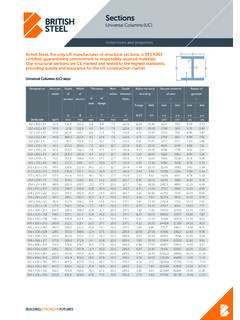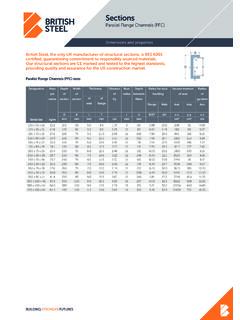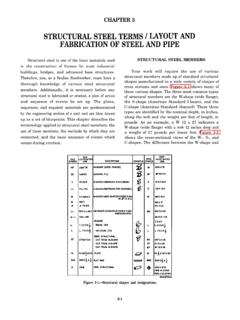Transcription of Chapter 4 –Microscopy - University of Illinois Urbana ...
1 Chapter 4 Microscopy Gabriel PopescuUniversity of Illinois at Urbana ChampaignypgBeckman InstituteQuantitativeLightImagingLaborat oryElectrical and Computer Engineering, UIUCP rinciples of Optical ImagingQuantitative Light Imaging 460 Optical Imaging The Microscope can be approximated by 2 lenses [ [ [ , ]]] Resolution of Optical MicroscopespppyTube lensSampleF2 F2 Objective[ [ [ , ]]]yU(x,y)F 1[[ ]]FUxy[[[ ]]] []xyFFUU sign means inverted image Theobjectiveisthemostimportantpartofthem icroscope1[[,]]FUxy21[[[,]]][,]yFFUxyUMM The objective is the most important part of the microscope Usually a third lens (ocular) images F2 at , such that we can visualize it with the relaxed 4: Microscopy 460 Optical Imaging The objective lens dictates the resolution or size of the Resolution of Optical Microscopesjsmallest object that the microscope can resolve. Contrast is generated by absorption, scattering, etc.
2 Microscopes can be categorized by the methods that they use to produce contrast. Let sconsideraninfinitelysmallobject(point): Let s consider an infinitely small object (point):x1x2xM M How small can we see?ff3 Chapter 4: Microscopy 460 Optical Imaging Fourier properties of the lens; the reconstructed field Resolution of Optical Microscopespp;( )112()[, ][, ]ix yUxyUedd We know that and because and MMxf MMyf We can access only a finite frequency range and therefore we can only achieve finite resolution. Wewouldneedaninfinitespectrumtoreconstru ctafWe would need an infinite spectrum to reconstruct a d function (in this case a point)4 Chapter 4: Microscopy 460 Optical Imaging Given the finite frequency support we can Resolution of Optical Microscopesqypp Where ( )[, ][,] [,]UUH 1 if , 0th i{MMH 10 otherwise{H So, eq. becomes( )[] [[][]]Uxy FUH ( )[,][[,][,]]Uxy FUH 5 Chapter 4: Microscopy 460 Optical Imaging Use the Convolution Theorem once more (which states that Resolution of Optical Microscopes(convolution in one domain is multiplication in another) to get: ( )[, ][, ] [, ]Uxy Uxy hxy V()ix y Where is the microscope imageis the ideal imageistheimpulseresponse[, ]Uxy[, ]Uxy[]hx y()ix ye is the impulse response [,]hx y[, ][ [, ]]hx y FH ( ) 2221 if 0 otherwise[, ][]xyffwxyLHf fcircw p( ) w2w6 Chapter 4: Microscopy 460 Optical Imaging So,11where is a Bessel function of the 1st kind and order[2][], 2 JJWFHAhW Resolution of Optical Microscopes, So the image of a point becomes:2W 2221[2][, ]2 JWhx yAW ( ) Since and2W 1[]2Jx MMxWf Hx so2x fThe Airy 61f so.)}}
3 61f (eq. )A point will be imaged as a smeared spot of diameter Mx 7 Chapter 4: Microscopy 460 Optical Imaging Imagine that we have two such points. Then the resolution is Resolution of Optical Microscopesgpthe minimum distance between the points that are separated, which is . = resolution An objective lens that allows higher spatial frequencies (or jgpq(angles) provides a higher 4: Microscopy 460 Optical Resolution of Optical Microscopes1 S1 MxS2Mx2 Definition:11sintanMxf 1f1f2f2fThlibbidhf1sinNumerical ApertureNA ( ) The resolution becomes but is good enough Compare Ob1and Ob2above:.61NA 2NA 12 12121 2 MMxxNANA (4 11) So Ob2 provides a better 12121 2, MMxxNANA ( )9 Chapter 4: Microscopy 460 Optical Imaging In general, objectives are made out of several lenses => Resolution of Optical Microscopescomplex systems 'PPFfWObjectiveEntrance Pupiljfocal distance measured from principal planeworking distance = distance from F to physical surface of lensEntrance Pupilimage of physical aperturefW Entrance Pupil = image of physical aperture and entrance pupil determine numerical aperf ture resolution 10 Chapter 4: Microscopy 460 Optical Imaging Note: if the objective lens is immersed in a medium for which Resolution of Optical Microscopesjn 1, then NAn NAn ( ) This means that it is possible for immersed objective lenses to have a better 4.)
4 Microscopy 460 Optical Imaging The final image consists of a distribution which is the [, ] Contrastgresult of absorption, scattering/diffraction, etc. Contrast = a measure of the intensity fluctuations across the iIlthttthbtt[, ]yimage. In general, the more contrast the ContrastHigh ContrastIIxx12 Chapter 4: Microscopy demo 460 Optical Imaging Microscope Contrastpg 2 regions of interest: A, B N is the background noise (in sample)( ) Contrast :,; = signal A, BABABA BCSSS Contrast to noise ratio:ABABABSSCCNR 2 = standard deviation of 22() ; = signal in pixelsNi iiSS S 13 Chapter 4: Microscopy 460 Optical Imaging While resolution is given by the instrument, the contrast is Contrastgy,given by the instrument/sample combination. Most biological structures ( cells) are very transparent so is flat, which means there is low contrast They can be assumed phase objects [, ]Ixy Example of a phase object:100 nm[, ]IxyImaging systemWave frontN= Glass Profile Phase Grating14 Chapter 4: Microscopy ECE 460 Optical No absorption so[, ]constant contrast = 0 Ixy Contrastp BUT:the wave front carries information about the sample[, ]y( )[,][]ixyExy E e This is the expression for the field in the vicinity of a phase object()0[,]Exy E e object.
5 Bright Fieldmicroscopy produces low contrast images of phase objectspj15 Chapter 4: Microscopy ECE 460 Optical There are several ways to enhance contrast: Endogeneous Contrastg Dark field Phase contrast Schlerein Quantitative phase microscopy Confocal Endogeneous florescenceg Exogeneous Contrast Agents Staining FlorescenttaggingFull fieldFlorescent tagging More recently Beads (dielectric and metallic) NanoConfocalNano Quantum Dots16 Chapter 4: Microscopy 460 Optical Imaging Consider the low contrast imageI( ) Dark Field MicroscopyI(x)xI(x,y) Typical low pass filtering = remove CI(x)I(f)Remove low I(x)xFourierI(fx)fxFrequency Then take the inverse Fourier TransformationInverseI(x)Inverse FourierI(x)xHigh Contrast17 Chapter 4: Microscopy 460 Optical Imaging Actual Dark Field MicroscopyfObjectLensBlocks low Enhanced Contrastfrequency High frequency components are enhanced (eg. edges)(gg) Without the sample Dark Field18 Chapter 4: Microscopy 460 Optical Imaging Not used very often nowadaysBlocks SchlereinMethodspectrumImage PlaneFourierInverse Fourier Enhances Contrast Phase objects can be rendered visible Edgesareenhanced Edges are enhanced Relates to Hilbert 4: Microscopy 460 Optical Imaging Exercise: Show the following for a real signal f(x)Cut SchlierenMethodf(x) F(g) Ft(g) f(x)FourierCut spectrumInverse Fourier~() andfx Hilbert1(')()()'22'Pfxfxfxidxxx To the left: David Hilbert a German Mathematician, recognized as one of the most influential and universal mathematicians ofthe19thandof the 19th and early 20th 4: Microscopy 460 Optical Imaging Developed by Frits Zernike (1935) yielding Noble prize in 1953(Physics) Phase Contrast Microscopy1953(Physics) Very powerful, commonly used today.
6 Consideraphaseobject:Consider a phase object: Intensity distribution: (,)(, )ixyUxy e ( )2(, )1 No Contrast Ixy U Assume: The microscope has a magnification M=1(x,y)(x ,y )Fourier PlaneSImage plane21 Chapter 4: Microscopy 460 Optical Imaging2()(, )(,) xyiffxyUffUxyedxdy( ) Phase Contrast Microscopy; xxxyffff Note: Central Ordinate Theorem(0, 0)( , ) UUxydxdy( ) Zero Frequency component corresponds to a plane wave in the image plane(constant of (x,y))Plane Wave1(,)Uxydxdy 01(,)UU x y dxdyA 22 Chapter 4: Microscopy 460 Optical Imaging Note: hif Phase Contrast Microscopy has no information about the structure of the ()UU x y dxdy 0U= Average fieldImageformationisaninterferencebetwe entheaveragefield0(,)UU x y dxdyA Image formationis an interferencebetween the average field and high frequency components. () [() ]UxyUUxy UHigh Frequency Ct00(,)[(,)]UxyUUxy U 1(,)Uxy( )Component1(,)y23 Chapter 4: Microscopy 460 Optical Imaging Phase contrast relies on shifting the phase of by Phase Contrast Microscopy00iUUae Assume ; becomes: Theintensitydistributionintheimageplane0 1U 00iUUae 00(, )[ (, ) 1]iUxy aeUxy (4 19) The intensity distribution in the image plane becomes:2(, )(, )Ixy Uxy ( )2(,)2()111 Re[222]iixyiiiaeeaaeaee 2[]2[1coscoscos()]aaa ( )24 Chapter 4: Microscopy 460 Optical Imaging Note: For a = 0 recover Dark Field Microscopy Assume small Phase Contrast Microscopy Assume small phase shift cos1.
7 2 222(, )2 sin sin2(,)sinIxy aaaaxy PC couples into intensity a<1enhancescontrast(bestmodulationfor) 2(, )2(, )Ixy aaxy ( )UU a<1 enhances contrast (best modulation for ) 01UU 25 Chapter 4: Microscopy Nomarski/Differential Interference Contrast iECE 460 Optical Imaging DIC= Differential Interference ContrastMicroscopy11 CondenserxMovable WollastonP1111000 SSWollaston Prism #1 Wollaston Prism #2 Obj. Usepolarizationdiscriminationtocreate2in terfering Use polarization discrimination to create 2 interfering beams Illuminate sample(s) with 2 drifted beamsp()26 Chapter 4: Microscopy Nomarski/Differential Interference Contrast iECE 460 Optical Imaging Shift amount Airy disk2NA Microscopy Wollaston prism #2 brings the 2 beams together through it 10iiTotalEEE Ae Ae ( ) 10 10cosdnkndk 27 Chapter 4: Microscopy Nomarski/Differential Interference Contrast iECE 460 Optical Imaging By varying the position of Wollaston prism Microscopyone can adjust Phase Shift through the sample:10 ()ixdxe ()ixe S becomes:00110()0()0[1]niiTotalniiEAe AeAee ( )0[]ee28 Chapter 4: Microscopy Nomarski/Differential Interference Contrast iECE 460 Optical Imaging The Intensity in the image plane (as a function of Microscopydisplacement x).
8 F0() 2 (1 cos[() () ])IxIx dxx ( ) Note: For small , best results obtained for 0( )2 (1 sin[ ()( )])IxIx dxx 2 Shfi liidi ib iildhdi0()()2[1]xdxxIdxdx ( ) So the final intensity distribution is related to the gradient of the phase:()xx 29 Chapter 4: Microscopy Nomarski/Differential Interference Contrast iECE 460 Optical Imaging DIC is a very sensitive to edges, even though the actual Microscopyphase shifts are small . Example:sampleIt itxIntensity no contrastxxPhttdDIChildtdillf Phase contrast and DIC heavily used today, especially for investigating live biological structures (cells) 4: Microscopy 460 Optical Imaging PC &DIC are great, but qualitative in terms of Quantitative Phase Microscopy Knowing quantitatively offers some advantages, gives a map of structure density; for homogeneous structures, gives molecular information.(, )xy QPM is a rather new domain; several methods so far.
9 Main obstacle is noise31 Chapter 4: Microscopy 460 Optical Imaging So far, we discussed full field imaging, obtaining the entireimageatonce( Confocal Microscopyentire image at once(great feature: imaging as a parallel process). The image can be recorded point by point also(like TV), sometimes with some advantages. Confocal = same focal point for illumination and collectionPinhole32 Chapter 4: Microscopy 460 Optical Imaging Due to pinhole, light out of focus is rejected, which can Confocal Microscopycreate stacks of slices, hence 3D rendering Scanning: either by scanning the sample or the beam Note:Note: 3D Info large field of view (limited by aperture) up to better resolution ! It works in reflection usuallyBS2 Pinhole33 Chapter 4: Microscopy 460 Optical Imaging Recent development: Multi Confocal Microscopy/ NSOM Improves acquisition time Need more power Trade offMultiple Focused beam Confocalcan provide many frames/seconds(video rate) Leading to 4D imaging(x,y,z,t)34 Chapter 4: Microscopy 460 Optical Confocal Microscopy/ NSOM Near Field Scanning Optical Microscope(NSOM)Ci iffl&AFM Continuation of confocal & AFM Tappered fiber as cantilever :FiberAperture down to 50 nmEvanescent waves (no transmission in air)35 Chapter 4: Microscopy Confocal Microscopy/ NSOMECE 460 Optical ImagingSample50 100nm D Evanescent waves couple into sample Became propagating ldbdff Not limited by diffraction Drawback: scanning time; difficult in liquids36 Chapter 4: Microscopy 460 Optical Imaging Illumination and emission have different Fluorescence Microscopy Endogenous Fluorophoress eg.)
10 NADH Most commonly exogenous Recently: GFP technology (given fluorescent protein) geneticallyencodedfusedwithDNA genetically encoded, fused with DNA GFP live cell imaging allowsformultiple fluorophores allows for multiple fluorophores dynamic monitoring of processes(cell signaling) 37 Chapter 4: Microscopy 460 Optical Imaging Fluorescence adds specificity to the measurement. (organelledynamicsprocessspecific) Fluorescence (organelle dynamics, process specific) Typically epi fluorescence( reflection geometry) BSFilter< Filter blocks the excitation light 38 Chapter 4: Microscopy 460 Optical Imaging Full Field is limited to thin samples Combinefluorescence& Fluorescence Microscopy Combine fluorescence & confocal leads to deeper penetration Issues when imaging live cells: acquisition time, sensitivity, damage. Photo bleachingcan produce cell damage: limit duration of illumination need efficiency sensitivityiifi dCCD use intensified CCD Acquisition speed: improve with multi foci &Nipkow disk scanning39 Chapter 4: Microscopy 460 Optical Imaging Other Fluorescence Techniques:Tlilfl Fluorescence Microscopy Total internal reflection FCS Fluorescence correlation spectroscopy FRAP Fluorescencerecoveryafterphotobleaching FRAP Fluorescence recovery after photobleaching FRET Fluorescence resonance energy transfer.







